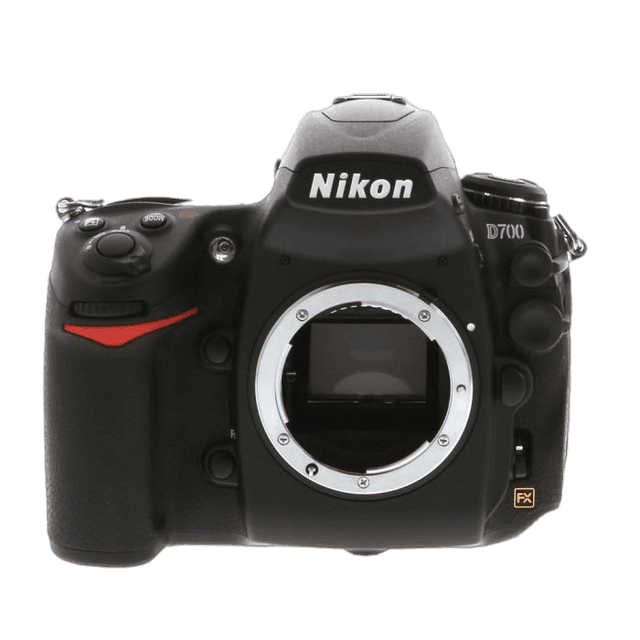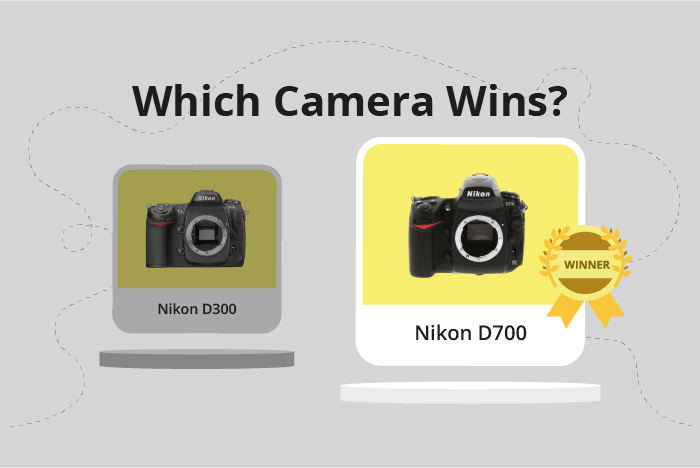Nikon D300 vs D700 Comparison
Nikon D300

Nikon D700

The Nikon D700 emerges as the winner with a score of 53/100, outperforming the Nikon D300 by 4 points. Both cameras share similarities as DSLR models released in the late 2000s, with the D300 announced in 2007 and the D700 in 2008. They also have the same camera width and depth measurements.
The D700 excels with a higher score and a larger height dimension, providing a more comfortable grip. However, it comes at a higher launch price of $2699 compared to the D300’s $1540. The D300 has the advantage of being lighter, weighing only 925g, whereas the D700 weighs 1074g.
Taking these specifications into account, the D700 proves to be a better camera, but the D300 offers a more affordable and lightweight option.
Nikon D300 vs D700 Overview and Optics
The Nikon D700 outperforms the Nikon D300 in optics with a score of 54/100 compared to the D300’s 47/100. Both cameras share some specifications, such as the CMOS sensor type, Expeed processor, and the absence of image stabilisation. Despite these similarities, the D700 proves to be a superior camera in terms of optics.
The Nikon D700 excels with its full-frame sensor, which provides better image quality and low light performance compared to the D300’s APS-C sensor. Additionally, the D700 has a higher DXOMARK score for the sensor at 80, while the D300 scores 67. This indicates that the D700’s sensor performs better in terms of dynamic range, color depth, and low light capabilities. The D700 also has an advantage in shooting speed, capturing 8 frames per second (fps) compared to the D300’s 6 fps. This makes the D700 more suitable for fast-paced photography, such as sports and wildlife.
The Nikon D300, however, has a slight edge in terms of megapixels, with 12.3 compared to the D700’s 12.1. This small difference allows the D300 to capture marginally more detailed images, although the overall impact on image quality is minimal. The D300 also has the Nikon F DX lens mount, while the D700 uses the Nikon F FX mount. This means that the D300 is compatible with a wider range of lenses specifically designed for APS-C cameras, potentially offering more versatility in lens choices.
Despite the Nikon D300’s advantages in megapixels and lens compatibility, the Nikon D700’s superior sensor performance, full-frame sensor, and faster shooting speed make it the clear winner in terms of optics.
Nikon D300 vs D700 Video Performance
When examining the video capabilities of the Nikon D300 and Nikon D700, it is important to note that neither camera has video functionality. This means that both cameras lack the ability to record video footage. Therefore, a comparison of their video capabilities is not applicable, as they both share the same limitation in this aspect.
Nikon D300 vs D700 Features and Benefits
The Nikon D300 and Nikon D700 both have a feature score of 54/100. Examining their specifications reveals the similarities and differences responsible for this identical score.
Both cameras share common specifications, including a 3-inch screen size and a screen resolution of 922,000 dots. Neither camera has a touchscreen, flip screen, GPS, or Bluetooth capabilities. These shared features contribute to their equal feature scores.
The Nikon D700 surpasses the D300 in one aspect: it has Wi-Fi connectivity. This feature allows users to transfer images wirelessly and control the camera remotely, providing added convenience and flexibility. This advantage is the primary reason the D700 could be considered a better option than the D300 in terms of features.
On the other hand, the Nikon D300 does not offer any notable advantages over the D700. Both cameras have the same feature score, and the D300 does not possess any additional capabilities that would make it a better choice than the D700.
Given the equal feature scores and the Wi-Fi advantage of the Nikon D700, it is the better choice of the two cameras. The Nikon D300 does not offer any unique benefits that would justify choosing it over the D700. Users seeking a camera with more advanced and convenient features should opt for the Nikon D700, while those who do not require Wi-Fi connectivity may find the Nikon D300 to be a suitable option.
Nikon D300 vs D700 Storage and Battery
Both the Nikon D300 and Nikon D700 have identical storage and battery scores of 43/100. They share common specifications, such as having one memory card slot, using Compact Flash memory cards, offering 1000 shots of battery life, and having an EN-EL3e battery type. Neither camera offers USB charging.
The Nikon D300 accepts both Type I and Type II Compact Flash memory cards, giving users greater flexibility in choosing storage options. This advantage allows for higher capacity and faster memory cards if desired, making the D300 slightly better in terms of storage compatibility.
On the other hand, the Nikon D700 only accepts Type I Compact Flash memory cards, which could limit storage options for users. However, this limitation does not significantly affect the overall performance of the camera and may not be a major concern for many photographers.
Despite the minor difference in memory card compatibility, both cameras perform similarly in terms of storage and battery life. Users will find satisfactory performance in either option, as the shared specifications provide ample storage capacity and battery life for various photography needs.
Nikon D300 vs D700 – Our Verdict
Are you still undecided about which camera is right for you? Have a look at these popular comparisons that feature the Nikon D300 or the Nikon D700:

